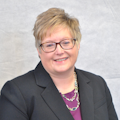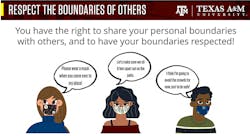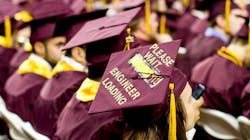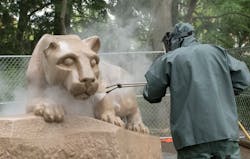What Can Engineering Students Expect This Fall?
By KELLY FALOON, Special to HPAC Engineering
The COVID-19 pandemic shut down much of the world this spring, including U.S. schools at every level. Elementary, high-school and college students found themselves at home, learning remotely at the family dining room table or on the couch in their apartments. It was not an ideal situation, certainly not one parents or students want to repeat, if it can be avoided.
Scientists will no doubt study this remote-learning phenomenon — perhaps they already are —to determine the positive and/or negative effects of such learning. But educators this summer can’t wait for those studies — they must make decisions now to ensure some sort of “normality” for the fast-approaching school year.
It is certainly a heightened concern for university/college administrators, who attract students from all over the U.S. — and all over the globe. With a rise in COVID-19 cases in this country and others, those administrators have been wrestling daily with difficult decisions to ensure the safety of students, faculty and staff while still trying to provide a quality education.
With that in mind, we checked in on several top engineering schools across the U.S. to see whether they plan to reopen campuses this fall for in-person classes, continue with remote learning, or combine the two. The information presented here focuses on undergraduate students. It’s also important to note that decisions on spring classes will depend on many factors that administrators simply cannot predict at this time.
Georgia Institute of Technology, Atlanta
Throughout the summer, Georgia Tech officials kept students updated on preparations for the fall 2020 semester, which begins Aug. 17. The fall break scheduled for Oct. 5-6 is canceled.
University System of Georgia institutions require all faculty, staff, students and visitors to wear an appropriate face covering while inside campus buildings where six-foot social distancing may not be possible, the university’s website notes. Those not using a face covering when required will be asked to wear one or must leave the area. Repeated refusal may result in discipline through the applicable conduct code.
Georgia Tech has reviewed all classrooms for possible reconfiguration. For classrooms unable to be configured to ensure social distancing, the school will provide face coverings, and either plastic lectern barriers or plastic face shields for faculty members to use while lecturing. In all courses, faculty will accept papers, projects, tests, homework, and other assignments only in electronic form, unless the assignment is a physical project.
Facilities management will clean classrooms, meeting/conference rooms, lobbies/stairs/common areas twice a day; restrooms and elevators will be cleaned four times a day. Frequently used touch points — such as handrails, light switches and door handles — are to be cleaned once a day. Wall-mounted hand sanitizer dispensers will be available near restrooms and in other common areas.
Georgia Tech developed five modes for Fall 2020 classes:
• Residential spread: Courses/sections that are residential (traditional format) with social distancing measures in place in the classroom. Priority for in-person delivery will go to lab classes, group project classes, senior design classes, hands-on sessions and small discussion classes;
• Hybrid hands-on: Courses/sections will offer lectures via remote delivery and bring students to campus for hands-on, studios and lab activities with social distancing measures in place;
• Hybrid touch points: Courses/sections will offer lectures in an online format and will bring students to the classroom several times during the semester for in-person experiences;
• Hybrid split: Courses/sections will offer lectures both in class and through broadcast recordings using classroom technology but will also bring smaller groups of students to the classroom on a predetermined basis, with proper social distancing measures in place;
• Remote: Courses/sections that are completely remote and delivered entirely online.
For students who believe they may have contracted COVID-19 on campus, Georgia Tech developed a “decision tree” infographic with information on symptoms and courses of action. It also developed a symptom checklist that officials encourage students to use every day.
Rapid testing is available to students with COVID-19 symptoms; those with no symptoms can be tested but on a prioritized basis. Contact tracing efforts will be led by the Georgia Department of Public Health.
For updated information, visit health.gatech.edu/coronavirus/students.
Texas A&M University, College Station, TX
Fall courses for most programs at Texas A&M begin Aug. 19 and run through Nov. 24, with final exams (online) set for Dec. 1-9. All students are required to complete the university’s COVID-19 Training and Certification by Aug. 11. This training educates students on COVID-19 symptoms, how to limit the spread, and what to do if they feel sick.
Courses will be offered three ways:
• Face-to-face: Also synchronously streamed remotely via Zoom from the classroom;
• Remote-only: Instruction delivered synchronously during scheduled class time via Zoom, although asynchronous activities may be used;
• Online: Prepared specifically using principles for online learning; instruction may be delivered either synchronously during scheduled class time or asynchronously.
“More that 50 percent of course sections are now offered face-to-face and 63 percent of students have two or more courses face-to-face (with a remote option),” says Carol A Fierke, provost and executive vice president. “We are making every effort to get all students at least one face-to-face course and most with two face-to-face courses (with a remote option).
“Given the need to be flexible, we notified all students that they should have access to a computer to use to complete their courses. Making this a university-level requirement should begin to address the inequities in students’ access to technology. Financial aid recipients may be eligible for additional funding to cover this purchase, while other students have access to emergency aid.”
To attend face-to-face classes, Texas A&M students must wear a face covering, or a face shield if they have an exemption letter, she adds. Students who refuse to wear a face covering and who do not leave class when directed can be reported and face sanctions.
Faculty may lecture in face shields if desired, although face coverings must be worn entering and exiting the building. Classrooms are marked with entrance, exit and seating directions.
Enhanced cleaning steps include:
• In most rooms on Texas A&M’s main campus, facility engineers have increased fresh air flow into the HVAC system and decreased the amount of recirculated air;
• Teaching spaces will be equipped with portable plexiglass shields for use by faculty when lecturing to provide protection for airborne droplets;
• Classrooms will be disinfected twice a day;
• High-traffic building lobbies and teaching spaces will receive an additional cleaning and disinfection;
• Large computer labs (more than 50 stations) will have a porter service to clean stations between student use.
In addition, hand sanitizer stands will be placed at entrances to every building and at each bank of elevators at every floor. The university will provide disinfectant spray bottles and paper towels to faculty and staff for use in the library, research labs, small computer labs and all classrooms.
Texas A&M students, faculty and staff who test positive for COVID-19. or who are experiencing symptoms, are required to self-report through an online form. This system centralizes the reporting of symptoms and/or exposure to the COVID-19 Investigation Operations Center. It was established in collaboration with the Brazos County Health District to augment area contact tracing efforts.
For updated information, visit www.tamu.edu/coronavirus/index.html.
Stanford University, Stanford, CA
Stanford will start the fall quarter one week early, Sept. 14, and end classes by Nov. 20. Final exams for all undergraduates (and most graduate students) will be held remotely the week after Thanksgiving, announced President Marc Tessier-Lavigne and Provost Persis Drell in a letter to the Stanford community in early June. For students unable to leave campus due to exceptional circumstances, a housing program will be available through the winter break, they noted.
Half of undergraduate students (the equivalent of two class years) will return to campus for the fall quarter and each subsequent quarter, changing each quarter, they explain: “It may need to be a smaller number in a given quarter if health conditions require it, which we hope will not be the case; in fact, we hope that health conditions will allow us instead to be able to expand access later in the year.”
For fall 2020, those will be freshman, sophomore and transfer students.
The university will have a four-quarter year that includes next summer, so that Stanford undergraduates can complete two quarters of instruction on campus in 2020-21, and require most to complete at least one quarter remotely. Seniors, juniors and sophomores can choose any three quarters in which to enroll. However, no student is required to return to Stanford for an in-person quarter.
Undergraduates on campus will be housed in rooms with private sleeping spaces, such as a single or a two-room double, to provide for sufficient physical distancing. “If we are to continue our on-campus operations, even if there is a resurgence of infections... we will need to have sufficient residential space available to allow students to quarantine or self-isolate on campus,” the letter stated.
All students, faculty and staff will need to wear face coverings regularly while on campus.
“Physical distancing protocols will be in place for our campus buildings and common spaces,” Tessier-Lavigne and Drell explained. “We expect limitations on gatherings. And we’ll likely ask students not to travel outside the local area while they are enrolled on campus, or otherwise to self-isolate upon their return.”
Stanford implemented an enhanced cleaning frequency to clean and disinfect common areas and commonly touched surfaces in occupied buildings. Touch-points such as entrance handles, handrails, elevator buttons, tables, restroom stall handles/doors are being cleaned at least once daily, five days a week. Unoccupied buildings receive a one-time, detailed deep cleaning and disinfection. Dispenser stations containing alcohol-based hand sanitizer will be installed at building entrances.
Various testing sites are available on campus and the surrounding area, although people with symptoms will take priority. Students and employees who are awaiting test results, have tested positive for COVID-19, or are sick with certain COVID-19 symptoms are required to inform the Office of Student Affairs.
For updated information, visit healthalerts.stanford.edu/covid-19/.
University of Illinois, Champaign, IL
Fall classes at U of I start Aug. 24 and will be a mix of in-person and remote instruction.
“Along with a successful transition of our region into Phase IV of Illinois Gov. J.B. Pritzker’s Restore Illinois plan, resuming on-campus instruction is predicated upon our ability to provide adequate COVID-19 testing for our entire community … coupled with a comprehensive plan that looks after the vulnerable, and aims at mitigating and containing any outbreaks,” administrators noted last month in an online FAQ session for students. “No decision about in-person instruction after Thanksgiving break has been made at this time.”
Classrooms for in-person courses will allow for adequate social distancing between students and faculty. “Scheduling classes during traditionally under-utilized days and times will also offer more in-person capacity,” the university notes.
Face coverings will be required in all campus spaces where social distancing of six feet cannot be maintained. This includes classrooms and outdoor space. Each on-campus student will receive two fabric masks. Students or faculty who do not comply will be asked to leave campus.
Hand-sanitizer stations will be located at building entrances, and many departments will have hand sanitizer to share with employees, students and visitors. The U of I facilities department will also use enhanced cleaning and sanitizing methods in all university spaces.
Also, all U of I students, faculty and staff are required to complete the Division of Research Safety’s COVID-19 online training, which provides education on COVID-19 symptoms and precautionary measures.
Saliva sample testing will be part of the standard entry and orientation for students returning to campus. The test was developed by a team of researchers at the Urbana-Champaign campus, which will have as many as 20 testing stations located across the university.
“It will be critical that individuals participate in the [university’s] testing and notification programs and make personal choices that follow the guidance of public health professionals — including wearing masks, washing hands, avoiding large gatherings and staying six feet apart when possible,” administrators stressed.
Students living on campus who test positive for COVID-19 or have symptoms will need to isolate in facilities reserved for that purpose. Champaign-Urbana Public Health District will have oversight for all contact tracing efforts.
For updated information, visit covid19.illinois.edu.
Massachusetts Institute of Technology, Cambridge, MA
At MIT, administrators determined that the best way to move forward for the fall semester — which starts Sept. 1 — is to limit the number of students brought back to campus.
“In planning for the fall, we took a very MIT approach: broadly consultative, science-based and intensely analytic,” notes L. Rafael Reif, MIT’s president. “Keeping the whole community safe will require that everyone living or working on campus be tested for the virus as often as twice a week, that each undergraduate living on campus has a private room and that the overall campus population … be kept far below our normal levels. Those constraints mean that we can invite back only a limited number of undergraduates for the fall term.”
So two groups were allowed to return for the fall: rising seniors, because they have the least flexibility to satisfy degree requirements and need campus resources for work in their programs; and a small fraction of other students whose circumstances require special consideration in terms of their safety, living conditions, visa status or other hardship.
“As a matter of equity, we believe it is important, in this academic year, to enable every student to spend at least one term on campus,” Reif adds. “Our hope is to offer every first-year, sophomore and junior the opportunity to be on campus for spring semester.”
Upon arrival to campus for the fall semester, MIT seniors living on campus will be tested for COVID-19 (results available after 24 hours), followed by a seven-day self-quarantine until they receive a second test, seven days later. As an extra precaution, the first week of classes will be conducted entirely online to accommodate the self-quarantine period. Students who are on campus will also be tested regularly for the virus through the fall.
Masks are mandatory and are to be worn outside a student’s room and in academic buildings, labs and other shared spaces. Other changes include:
• Required public-health education;
• Daily health verifications via an app or website;
• Physical distancing;
• Contact tracing;
• Staggered scheduling and reconfigured work spaces;
• Enhanced cleaning protocols;
• Access to buildings through a single point and only with MIT ID;
• No large gatherings or lectures.
For MIT students not living on campus, subjects for undergraduates will be taught online. For students on campus, MIT offers a combination of online and in-person instruction.
For updated information, visit covid19.mit.edu/fall-2020-faq.
Arizona State University, Tempe, AZ
Officials at Arizona State University began prepping students and their families in mid-June for a return to on-campus, in-person classes for the fall semester, which begins Aug. 20 — although they canceled the traditional fall break, scheduled for Oct. 12-13.
“Campus life will look different in many ways, and we will all need to make adjustments,” notes a message on the university’s website. “Everyone will be required to wear a face cover while in ASU buildings. Face coverings will also be required in outdoor community spaces where social distancing isn’t possible.”
All on-campus students will receive a “Community of Care” kit containing face coverings, a thermometer, hand sanitizer and other items for use in maintaining their health and wellness on campus, ASU notes. Employees will receive similar kits; all kits can be restocked through the university.
ASU installed sneeze guards and Plexiglas barriers for high-frequency visitor areas, touchless technology will be used where possible, and social distancing will be observed. Increased cleaning protocols include daily cleaning of classrooms with two additional cleanings of high-touch surfaces, providing cleaning and sanitizing supplies in all classrooms for students, and reducing attendance in classrooms by half on alternating days.
Students have three options for attending Fall 2020 classes:
• ASU immersion: On-campus, in-person, technology-enhanced learning environment;
• ASU Sync: Synchronous, technology-enhanced and fully interactive remote learning using live lectures via Zoom. This approach can be used simultaneously with in-person instruction to accommodate students in different circumstances and enable social distancing in classrooms or as stand-alone technology;
• iCourses: Courses delivered entirely online with lectures available on demand.
All students and employees will be pre-screened for information related to prior COVID-19 testing and travel. The university notes it will follow guidance from the Centers for Disease Control and Prevention regarding isolation requirements for individuals traveling from global or domestic hot spots.
To help ensure that those who are sick do not infect others on campus, ASU is introducing what it calls “proactive health monitoring,” where students and employees are encouraged to monitor their temperature each day they’re on campus. If their temperature is 100.4 degrees or higher, they should stay home and seek health advice.
Saliva-based COVID-19 tests, with a 24- to 48-hour turnaround time for results, are now available at ASU. The university will prioritize testing for any student or employee who is exhibiting symptoms or may have been exposed to someone with COVID-19. ASU has staff available to support contact tracing as needed.
For updated information, visit www.asu.edu/about/fall-2020#preventive-measures.
Pennsylvania State University, University Park, PA
Penn State’s fall 2020 semester begins Aug. 24, students can attend classes in person, remotely or a hybrid of both modes, the Penn State News reports. All classes of more than 250 students will be delivered online/remotely.
However, campus-based instruction will end Nov. 20, with the remainder of the semester — including final exam — delivered remotely and online when classes resume after Thanksgiving break. (To minimize travel and lower the risk of COVID-19 transmission, classes will be held on Labor Day, Sept. 7).
For hybrid or “COVID mixed” courses, options include:
• Rotating lecture attendance where some portion of the class attends in person and the others attend via a remote synchronous environment;
• Lectures delivered remotely combined with in-person small group recitations or problem-solving sessions; and
• Lectures delivered remotely combined with in-person small group laboratory or performance sessions.
Before returning to campus, administrators are asking students if they have exhibited COVID-like symptoms or have reason to believe they were exposed to COVID-19 to self-quarantine and seek testing. Administrators, as a precaution, are encouraging all students who can to self-before arrival.
Face masks/coverings and social distancing are mandatory for everyone on campus — in classrooms, labs, offices and campus buildings. The university purchased 500,000 face masks for all campuses, which are available to students and employees, the Penn State News reports. Students are asked to sign a pledge to affirm that they will adhere to basic, but crucial, public health guidelines on and off campus.
“We know students are concerned for the health of themselves and others, and we hope they will honor and follow these requirements and guidelines and that their peers also will encourage good behavior both on and off campus,” Danny Shaha, assistant vice president for student rights and responsibilities, told the publication. “However, instances where students do not comply with these requirements in university buildings and classrooms, and put others’ health at risk, will be addressed.”
In addition, Penn State modified some indoor spaces to minimize the transmission of the novel coronavirus — including plexiglass shields in high person-to-person contact areas and one-way traffic directions in high-density areas.
Penn State’s facility maintenance staff will conduct extensive, daily cleaning of high-touch surface areas, such as classrooms, labs, offices, restrooms and other common spaces. Several thousand hand-sanitizer stations were placed in high-traffic areas; hand sanitizer or cleaning wipes are available for each classroom and classroom building.
Testing and contact-tracing programs will test symptomatic individuals and conduct asymptomatic testing on individuals who are identified in the contact-tracing process. Penn State also is building capacity to isolate and quarantine impacted individuals, including support for isolated persons, to facilitate proper medical care.
For updated information, visit virusinfo.psu.edu/back-to-state.
University of California - Berkeley, Berkeley, CA
Berkeley students will begin the fall 2020 semester Aug. 19 with fully remote instruction.
“However, we continue our preparations to implement hybrid and/or flexible modes of instruction as soon as public health conditions allow,” note university administrators Vice Chancellor for Student Affairs Stephen C. Sutton, Vice Provost for Graduate Studies and Dean of the Graduate Division Lisa Garcia Bedolla, Vice Chancellor for Undergraduate Education Catherine P. Koshland, and Vice Chancellor for Equity and Inclusion Oscar Dubón.
The administrators add they plans to go fully remote after Thanksgiving will move forward, even if they are able to offer some in-person instruction during the fall semester.
“COVID-19 is showing us that we have to be not only agile, moving quickly between degrees of openness and sometimes pulling back, but also prepared to move forward as soon as conditions allow,” they explain. “In general, if you can reasonably live and learn where you are right now, staying there may be the preferred choice for you.”
For any students or staff who are on campus face coverings/masks are required, as is physical distancing. Refusing to comply with those requirements will result in consequences that could include being excluded from campus altogether. For faculty and staff working on campus, there is an online daily symptom screener to help them determine if they should go to work or stay home.
For updated information, visit coronavirus.berkeley.edu.
##########
Based in Chicago, the author is a contributing writer to HPAC Engineering magazine. The former editor of Plumbing & Mechanical magazine, she has more than 20 years’ experience in the plumbing and heating industry and B2B publishing. A native of Michigan's northern Lower Peninsula, Faloon is a journalism graduate of Michigan State University. Email her at [email protected].
About the Author

Kelly L. Faloon
Contributing Writer/Editor
Faloon spent 3 1/2 years at Supply House Times before joining the Plumbing & Mechanical staff in 2001. Previously, she spent nearly 10 years at CCH/Wolters Kluwer, a publishing firm specializing in business and tax law, where she wore many hats — proofreader, writer/editor for a daily tax publication, and Internal Revenue Code editor.
A native of Michigan’s northern Lower Peninsula, Faloon is a journalism graduate of Michigan State University. You can reach her at [email protected].






